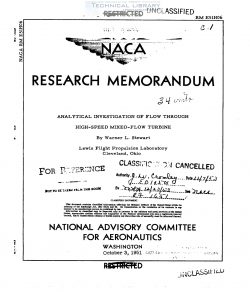naca-rm-e51h06
- Version
- 50 Downloads
- 939.62 KB File Size
- 1 File Count
- May 25, 2017 Create Date
- May 25, 2017 Last Updated
National Advisory Committee for Aeronautics, Research Memorandum - Analytical Investigation of Flow Through High Speed Mixed-Flow Turbine

An analysis was made of the flow through a mixed~flow turbine
designed to drive a highrSpeed, high-weight-flow compressor, of the
type that could.be used in supersonic aircraft. The analysis, which is
based on axially symmetric flow, was developed from a method previously
used to predict trends of flow in mixed-flow compressor impellers to _
include an analysis of the region downstream.of the rotor. Results of ’
the analysis indicate that the weight flow calculated by this three-
dimensional method is lower than that weight flow used in the two-
dimensional design of the turbine. The results also indicate that
redesign of the inner wall of the rotor can provide sufficient flow
area to allow design weight flow to pass and to alleviate the adverse
velocity and pressure gradients indicated in the analysis at the expense
of increased rotor blade stresses.
The development of high—speed, high—weight-flow transonic and
supersonic compressors particularly for high—speed aircraft is dependent
on the proper design of turbines to drive these compressors. In order
to determine the problems involved, a turbine was designed at the NASA
Lewis laboratory to drive a supersonic compressor that could be
installed in a supersonic aircraft.
The high rotational speed and_high—weight—flow characteristic of
these compressors caused high.turbine rotor blade stresses, which were
minimized by making the rotor blades highly tapered and the annulus area
at each station through the rotor as small as practical_from aerodynamic
considerations. The resulting turbine configuration is of the mixed-
flow type having a high degree of insweep of the inner wall.
Since no general method of designing mixed—flow turbines is
available, the preliminary rotor blade design was based on two-
dimensional flow and the effect of the hub—shroud profile and blade
taper was neglected. The large hub-shroud insweep and blade taper of
this turbine type, however, indicated the need for additional informa-
tion on the effects they would have on the flow. A method is presented
in reference 1 for computing the flow through a mixed—flow compressor
rotor. Based on axially symmetric flow and utilizing a numerical
solution and an iteration process, the method is also applicable to the
calculation of the flow through mixed—flow turbine rotors. Good experi—
mental correlation of the analytical results was obtained for the com-
pressor even though isentropic flow and axial symmetry were assumed
(reference 1). In order to determine the flow through the turbine being
investigated, however, it was necessary to extend the method of
reference 1 to include the flow downstream of the rotor since the large
blade taper and hub-shroud curvature caused downstream conditions which
affected the flow inside the rotor.
| File | Action |
|---|---|
| naca-rm-e51h06 Analytical Investigation of Flow Through High Speed Mixed-Flow Turbine.pdf | Download |

Comment On This Post